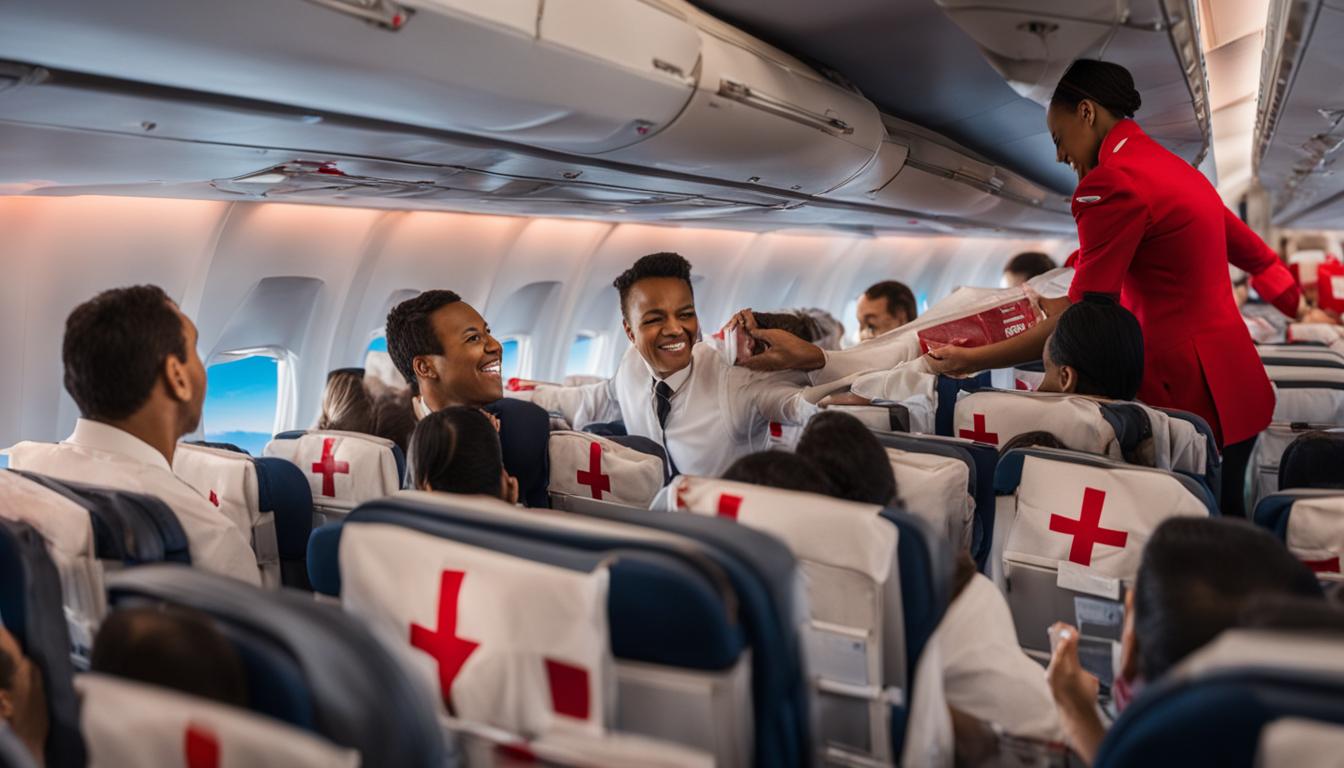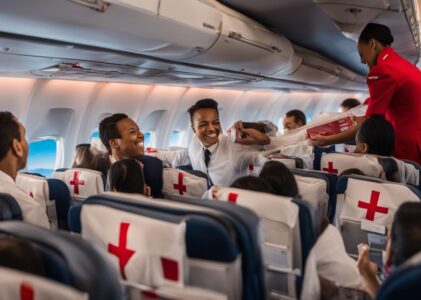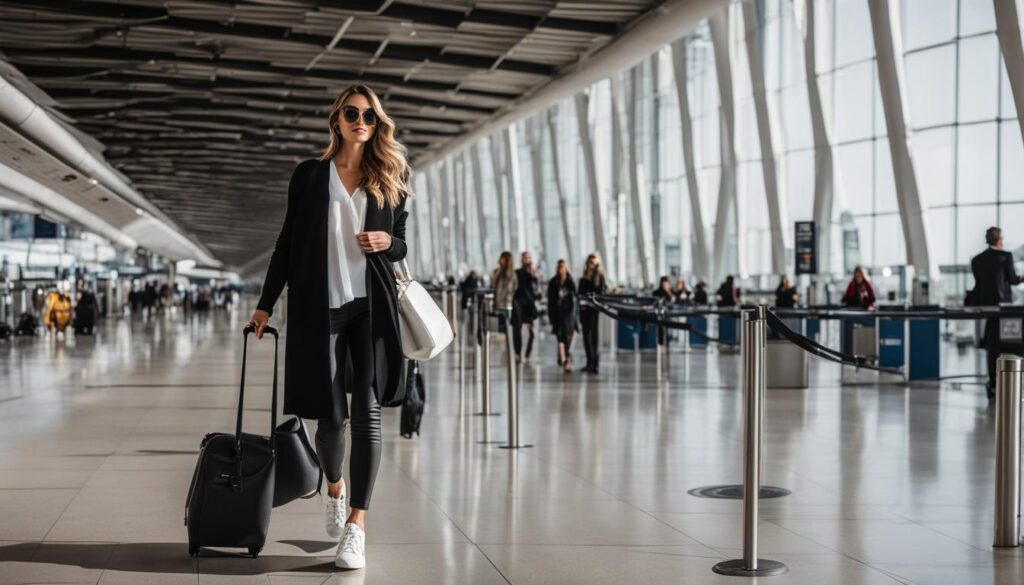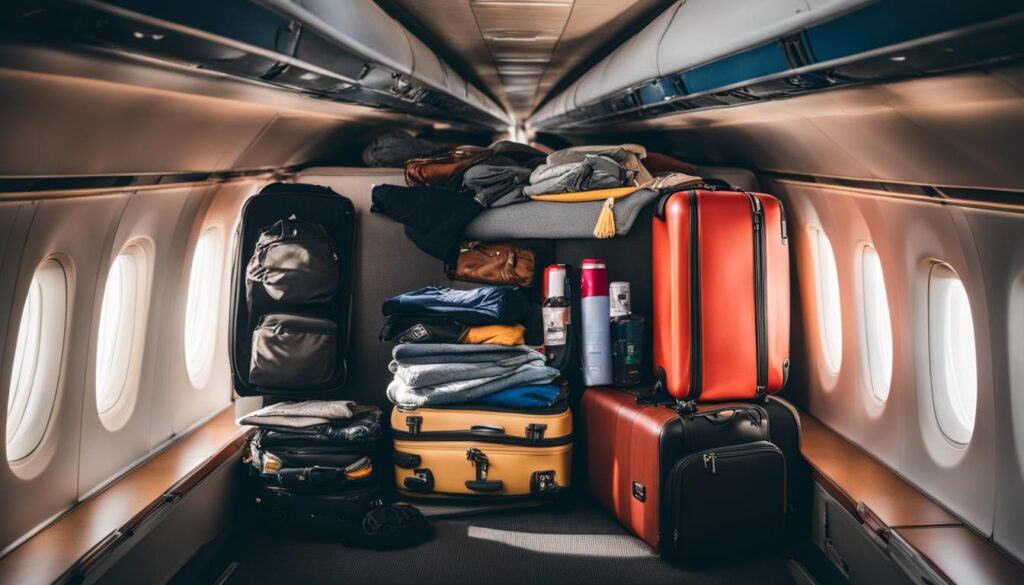As someone who values safety, it’s understandable to wonder if you can bring first aid kits on a plane. Fortunately, the answer is generally yes. However, there are some regulations you need to know before packing your kit for air travel.
The Transportation Security Administration (TSA) sets specific guidelines for carrying first aid kits on an aircraft. These regulations are in place to ensure the safety and security of all passengers onboard. By understanding and adhering to these guidelines, you can bring your first aid kit on a plane with ease.
Key Takeaways:
- It is generally allowed to bring first aid kits on a plane.
- The TSA regulates the guidelines and restrictions associated with bringing first aid kits on an aircraft.
- Follow the appropriate packing and safety precautions to ensure a hassle-free experience.
- Stay informed about the latest rules and regulations related to bringing first aid kits on a plane.
- Be mindful of any prohibited items related to first aid kits on flights.
Understanding Airplane Regulations for Carrying First Aid Kits
Are you planning on bringing a first aid kit on your next flight? Before you start packing, it’s important to know the specific regulations and guidelines associated with carrying a first aid kit on an airplane.
Packing First Aid Kits for Air Travel
When packing a first aid kit for air travel, there are certain things to keep in mind. Firstly, it’s essential to make sure that all items are securely and safely packed to prevent damage during transport. Additionally, you’ll want to ensure that any liquids or gels are packed in accordance with the 3-1-1 rule, which permits containers that are 3.4 ounces or less per item for liquids and gels, all of which must fit in a single quart-sized clear plastic zip-top bag.
It’s also important to note that while certain medications and first aid items are allowed on planes, others are not. For example, you can bring gel-filled ice packs, but they must be completely frozen at the time of screening. Conversely, items such as bleach or chlorine are not permitted due to their potentially hazardous nature.
What to Know About Bringing First Aid Kits on a Plane
Before you bring a first aid kit on a plane, it’s important to research the specific regulations that apply to your airline and destination. While most airlines allow first aid kits on board, there may be certain restrictions or prohibitions depending on the airline or country.
Additionally, it’s important to keep in mind that some items may raise concerns with airport security personnel. For example, certain sharp items such as scissors or razors may be permitted as long as they are properly stored and presented for screening. However, it’s important to note that airport personnel ultimately have the final say on whether an item is permitted on a flight.
Restrictions on Bringing First Aid Kits on a Flight
While first aid kits are generally permitted on flights, there are some restrictions to be aware of. For example, some airlines may have limitations on the size or weight of your first aid kit, or may not allow certain items such as needle-based medical devices. It’s important to research the specific regulations that apply to your airline and refrain from bringing any items that may be prohibited.
By understanding the specific regulations and guidelines associated with carrying a first aid kit on a plane, you can ensure a smooth and hassle-free travel experience with all of your essential medical supplies on hand.
TSA Rules for Bringing First Aid Kits on a Plane
When it comes to bringing first aid kits on a plane, there are guidelines set by the Transport Security Administration (TSA) that you must follow. These regulations exist to ensure the safety of all passengers and crew members on board.
Guidelines for Bringing First Aid Kits on an Aircraft
The TSA permits passengers to bring first aid kits on a plane, but there are a few rules you must adhere to. First, all items in the kit must be in compliance with the TSA’s liquid rules. This means that any liquids, gels, or aerosols must be in containers that hold 3.4 ounces or less and placed in a clear, quart-sized bag.
Additionally, all sharp objects in the kit must be securely wrapped to prevent injury to yourself or others.
Can You Take a First Aid Kit in Your Carry-On?
Yes, you can take a first aid kit in your carry-on luggage, but it’s important to remember that all items in the kit must comply with TSA regulations. If you’re unsure about a particular item, you can always check the TSA’s website or contact them directly for clarification.
Prohibited Items Related to First Aid Kits on Flights
While the TSA generally allows first aid kits on flights, there are a few items that are prohibited. These include:
- Explosives
- Flammable items
- Compressed gases
- Oxidizers and organic peroxides
- Poisons
- Infectious materials
- Radiopharmaceuticals
- Other hazardous materials
Before packing your first aid kit for a flight, be sure to review the TSA’s list of prohibited items to ensure that none of the items in your kit fall under this category.
“It’s important to remember that the TSA’s regulations regarding first aid kits are in place to ensure the safety of everyone on board. By packing responsibly and following the rules, you can have a well-equipped first aid kit for your air travel needs.”
Packing a First Aid Kit for Air Travel
When it comes to packing a first aid kit for air travel, there are a few important things to keep in mind. Here are some tips to help you prepare:
1. Know What You Can and Cannot Bring
Before you start packing your first aid kit, you need to familiarize yourself with the guidelines for bringing first aid kits on a plane. Remember, there are certain items that are prohibited, so make sure to check the TSA website before you start packing.
2. Optimize for Space and Weight
When you’re packing for a flight, space and weight limitations become especially important. Make sure to choose a compact, lightweight bag or container for your first aid kit. Consider removing any items that are not absolutely necessary, particularly those that are heavy or bulky.
3. Include Essential Items
While you may need to adjust the contents of your kit based on your specific needs and destination, there are some essential items that should be included in any first aid kit for air travel. These include:
- Adhesive bandages in various sizes
- Gauze pads and rolls
- Tweezers and scissors
- Antiseptic wipes or spray
- Pain relievers, such as ibuprofen or acetaminophen
4. Consider Destination-Specific Items
Depending on your destination, you may need to include additional items in your first aid kit. For example, if you’re traveling to a region with a high risk of insect bites, you may want to pack insect repellent or antihistamines. If you’re traveling to a remote area, you may want to include a snakebite kit or water purification tablets.
5. Label Your Kit
Make sure to label your first aid kit with your name and contact information. If you’re traveling with a group, you may also want to label the kit with the group’s name or a specific destination. This can help ensure that your kit is returned to you if it is lost or misplaced.
By following these tips, you can pack a comprehensive and compact first aid kit for air travel. Remember, always adhere to the relevant guidelines and regulations, and stay informed about any updates or changes.
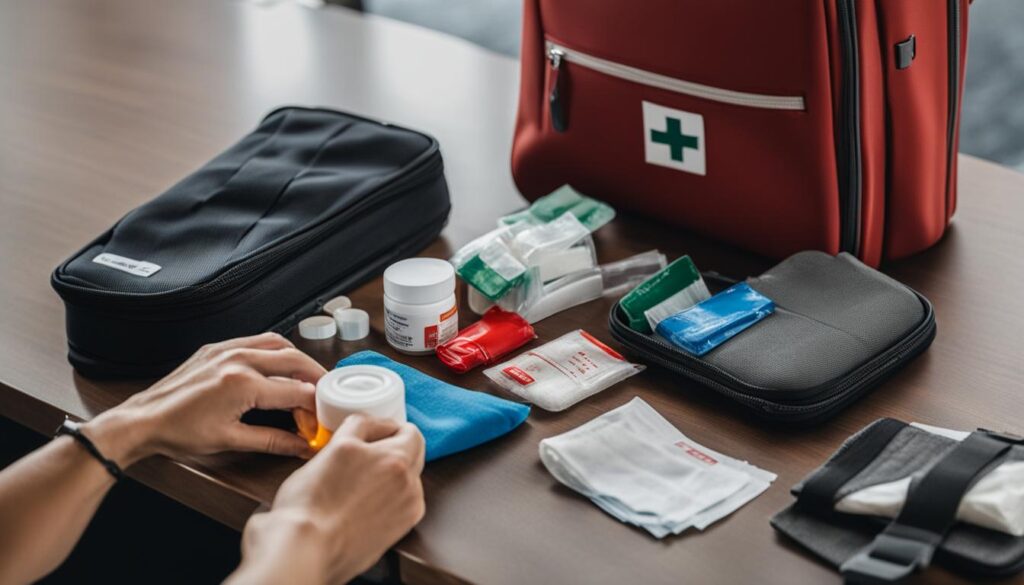
Understanding Safety Precautions for First Aid Kits on Flights
As I mentioned earlier, safety should always be a top priority when bringing first aid kits on a plane. Here are some important safety precautions to keep in mind:
- Store the kit securely: Make sure your first aid kit is stored in a secure and easily accessible location. It should not obstruct any exits or emergency equipment.
- Handle sharps properly: If your kit includes sharp objects such as scissors or needles, make sure they are properly stored and secured. You can also consider bringing along a travel-sized sharps container to dispose of any used items.
- Label the kit clearly: Make sure your first aid kit is clearly labeled with your name, contact information, and the contents of the kit. This will help in case the kit gets lost or misplaced during your travels.
Additionally, it’s important to be aware of any potential hazards that may arise during a flight. For example, changes in altitude and cabin pressure can exacerbate certain medical conditions, such as ear infections or respiratory problems. It’s a good idea to consult with your doctor before traveling if you have any underlying health conditions.
Tip: If you’re unsure about the safety of any item in your first aid kit, you can always check with the airline or TSA before your flight.
By following these safety precautions and staying vigilant during your flight, you can ensure that your first aid kit is a valuable asset during your travels.
Benefits of Having a First Aid Kit on a Plane
When I travel by plane, I always make sure to bring a first aid kit with me. Not only does it provide peace of mind, but it can also be extremely helpful in case of minor injuries or emergencies. Here are some of the benefits of having a first aid kit on a plane:
Bringing Medical Supplies on a Plane
In addition to a first aid kit, I also bring other medical supplies on a plane. This includes any medications that I need to take regularly, as well as over-the-counter painkillers, allergy medication, and other essentials. It’s important to know the TSA rules for bringing first aid kits on a plane and any other medical supplies that you may need to bring.
TSA Rules for Bringing First Aid Kits on a Plane
The TSA has specific guidelines for bringing first aid kits on a plane. They allow passengers to bring a standard first aid kit in their carry-on luggage. However, there are restrictions on certain items, such as sharp objects like scissors or tweezers. Make sure to check the TSA guidelines before packing your first aid kit for a flight.
Peace of Mind
Having a first aid kit on a plane gives me peace of mind, knowing that I am prepared for any minor injuries or emergencies that may occur. Whether it’s a headache, a blister, or a cut, I know that I have the supplies I need to take care of it. This can make a big difference in reducing stress and anxiety while traveling.
Assisting Others in Need
Bringing a first aid kit on a plane can also potentially help others in need. If a fellow passenger experiences a medical issue and needs assistance, having a first aid kit on hand can make a big difference. It can help to stabilize the situation until professional medical help arrives.
Overall, bringing a first aid kit on a plane is a smart and responsible decision. By following the appropriate guidelines set by the TSA and packing the right supplies, you can ensure that you are prepared for any minor injuries or emergencies that may occur while traveling.
Tips for Navigating Security Checkpoints with a First Aid Kit
If you’re carrying a first aid kit on a plane, it’s important to be prepared when going through security checkpoints. Here are some tips:
- Keep the kit in an easily accessible place: When packing your carry-on luggage, make sure the first aid kit is easily accessible so that you can remove it quickly when going through security. Don’t bury it at the bottom of your bag!
- Declare the kit to security personnel: When you get to the front of the security line, let the security personnel know that you’re carrying a first aid kit with you. They may need to inspect it separately from the rest of your luggage.
- Follow TSA guidelines: Make sure the first aid kit is packed in accordance with TSA rules for bringing first aid kits on a plane. This means ensuring that all liquids are in containers of three ounces or less and placed in a clear, plastic, quart-sized bag.
- Label the kit clearly: Make sure the first aid kit is clearly labeled with your name and contact information in case it gets separated from you. You can also consider labeling it as a first aid kit to make it easier for security personnel to identify.
- Be respectful to security personnel: Remember that the security personnel are just doing their job. Be patient and follow their instructions, and you’ll be through security in no time.
By following these tips and being prepared, you can navigate security checkpoints with a first aid kit hassle-free.
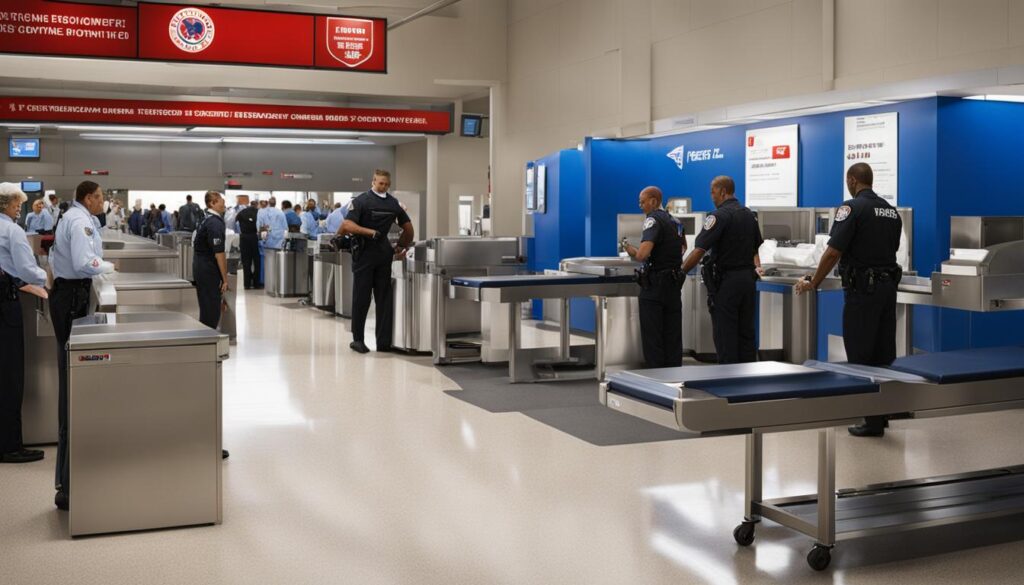
Bringing Medical Supplies on a Plane: What You Need to Know
When it comes to air travel, it’s important to know the rules and regulations surrounding bringing medical supplies on a plane. In addition to first aid kits, there may be other medical supplies that you need to bring with you. Here’s what you need to know:
Airplane Regulations for Carrying Medical Supplies
The transportation of medical supplies on board an aircraft is regulated by the Federal Aviation Administration (FAA) and the Transportation Security Administration (TSA). As with first aid kits, medical supplies should be packed in your carry-on luggage.
It’s essential to note any restrictions related to medical supplies, particularly those that are sharp or could be hazardous in-flight. For example, scissors or scalpel blades must be sheathed or securely wrapped to prevent injury to others.
Types of Medical Supplies
Medical supplies that are necessary for a medical condition or injury are allowed on a plane. Examples include:
- Insulin and other medications
- Medical devices, such as inhalers or oxygen tanks
- Other supplies, such as bandages and gauze
As with first aid kits, it’s essential to adhere to specific guidelines when carrying medical supplies. Be sure to pack your supplies appropriately and declare them to TSA personnel at the security checkpoint.
Additional Guidelines for Carrying Medical Supplies
Along with the specific rules regarding medical supplies, there are several additional guidelines to keep in mind. These include:
- Carry a letter from your healthcare provider that outlines your medical condition and any necessary treatment.
- Ensure that all medications and medical supplies are clearly labeled and in their original packaging.
- Store all medical supplies securely to prevent damage or loss during transit.
“It’s essential to adhere to specific guidelines when carrying medical supplies.”
By following these guidelines, you can ensure that your medical supplies are safely transported and readily available when you need them. Remember to always stay informed about the latest rules and regulations to ensure a smooth experience while carrying medical supplies on a plane.
Prohibited Items Related to First Aid Kits on Flights
If you are planning to bring a first aid kit on a plane, it’s important to be aware of the specific prohibited items related to first aid kits on flights. The Transportation Security Administration (TSA) has strict guidelines in place to ensure the safety of all passengers. Violating these rules can result in hefty fines and even criminal charges. Therefore, it’s crucial to pack your first aid kit with caution and be mindful of what you include.
Prohibited Items
According to the TSA, any sharp objects that could potentially cause harm are strictly prohibited in carry-on luggage. This includes scissors, pocket knives, and any blades longer than 3 inches. If your first aid kit includes any of these items, they must be stored in your checked luggage.
In addition to sharp objects, there are certain types of medications that are also prohibited on flights. For example, any medications containing chloroform, dissolved gases, or flammable substances are not allowed on a plane. It’s essential to carefully review all medications included in your first aid kit to ensure that they are permitted on the flight.
The Importance of Compliance
Complying with the TSA rules for bringing first aid kits on a plane is crucial for the safety of all passengers and crew members. The TSA takes these regulations very seriously and has a zero-tolerance policy for any violations. Therefore, it’s important to familiarize yourself with the guidelines and restrictions related to first aid kits and ensure that your kit is packed in accordance with these rules.
If you’re unsure whether a particular item is allowed on a plane, it’s best to err on the side of caution and leave it out of your first aid kit. Remember, safety is paramount when it comes to air travel, and it’s always better to be safe than sorry.
Conclusion
So, can you bring first aid kits on a plane? The answer is yes! However, it’s important to follow the regulations set by the TSA to ensure a smooth and safe journey.
Remember to pack your first aid kit appropriately, keeping in mind any restrictions on liquids and sharp objects. It’s also crucial to label your kit properly and handle sharps with care.
Bringing a first aid kit on a plane can provide numerous benefits, including peace of mind and the ability to assist yourself or others in need.
When navigating security checkpoints with your kit, it’s important to be prepared and follow proper procedures. Present your kit in a clear plastic bag and inform the security personnel that you are carrying medical supplies.
It’s also worth noting that while most items in a first aid kit are allowed on a plane, there may be specific prohibited items. Be sure to check the TSA’s guidelines to ensure that your kit is compliant.
In conclusion, packing a first aid kit and bringing it on a plane is a responsible and smart decision. With proper preparation and adherence to regulations, you can ensure a safe and comfortable flight for yourself and those around you.
Thank you for reading and happy travels!
FAQ
Can you bring first aid kits on a plane?
Yes, you can bring first aid kits on a plane. However, there are certain guidelines and regulations set by the Transportation Security Administration (TSA) that you need to follow.
What are the airplane regulations for carrying first aid kits?
When packing a first aid kit for air travel, make sure to comply with TSA rules. You should avoid including any items that are prohibited and ensure that all sharp objects are securely packaged to prevent injury during the screening process.
What are the TSA rules for bringing first aid kits on a plane?
The TSA allows you to bring a first aid kit in your carry-on luggage. However, certain items like flammable or hazardous materials may be restricted. It’s important to review the TSA’s guidelines to ensure compliance and avoid any issues at security checkpoints.
How should I pack a first aid kit for air travel?
When packing a first aid kit for air travel, include essential items like bandages, antiseptic wipes, and pain relievers. Make sure that your kit is within the size limits prescribed by the airlines and check for any restrictions on carrying liquids or sharp objects.
What safety precautions should I consider for first aid kits on flights?
To ensure safety when carrying a first aid kit on a plane, store it securely to prevent items from shifting during turbulence. Use caution when handling sharps and make sure to label the kit clearly. It’s also a good idea to familiarize yourself with basic first aid procedures.
What are the benefits of having a first aid kit on a plane?
Bringing a first aid kit on a plane can provide peace of mind and help you respond to minor injuries or emergencies. It can also allow you to assist others in need and ensure you have the necessary supplies to address common medical situations during air travel.
How can I navigate security checkpoints with a first aid kit?
To navigate security checkpoints smoothly with a first aid kit, present it separately for inspection. Remove any liquids or sharp objects from the kit and place them in a clear, resealable bag. Follow the instructions of security personnel and be prepared to answer any questions.
Can I bring other medical supplies on a plane?
In addition to first aid kits, you may need to bring other medical supplies on a plane. Make sure to review the rules and regulations regarding the specific items you intend to carry. It’s always a good idea to consult with your healthcare provider or the airline for guidance.
What items are prohibited related to first aid kits on flights?
While first aid kits are generally allowed on flights, there are certain prohibited items. These may include flammable liquids, sharp objects like scissors or needles, and certain medication or chemicals. Familiarize yourself with the TSA’s guidelines to ensure compliance and avoid any issues.

